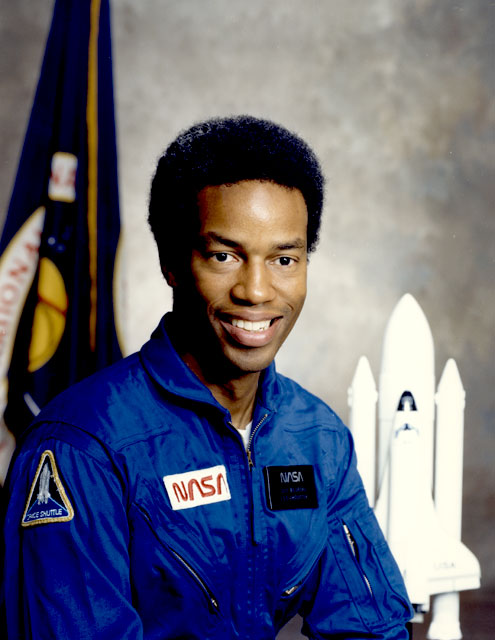Reaching for the Stars: Blacks in Space
by Tracy Dixon
Without the dedicated work of Black scientists, humans would never have walked on the moon. From devices for tracking space ships, to rocket engines and airborne radar systems, Blacks have continuously played a role in revolutionizing space travel in the United States. Blacks have not only helped to create the mechanisms used to send humans skyward but have participated themselves in space missions.
 Dr. Vance H. Marchbanks, born in 1905, was appointed Head Physician for the first U.S. space project. He was responsible for determining the effects of space flight on human physiology. Marchbanks collected medical information on astronauts throughout their flight and assisted in designing space suits for the Apollo missions that eventually put Americans on the moon.
Dr. Vance H. Marchbanks, born in 1905, was appointed Head Physician for the first U.S. space project. He was responsible for determining the effects of space flight on human physiology. Marchbanks collected medical information on astronauts throughout their flight and assisted in designing space suits for the Apollo missions that eventually put Americans on the moon.
In the 1960’s, Marchbanks became Chief of Environmental Health Services with the United Aircraft Corporation, where he completed important research in the control of noise from aircraft. He also developed a method of measuring fatigue in aircraft pilots involved in plane accidents. Marchbanks is currently a colonel and surgeon in the U.S. Air Force.
Dr. Katherine G. Johnson, a mathematician, and physicist at the National Aeronautics and Space Administration (NASA) Langley Research Center in Hampton, Virginia, developed a mathematical method in the 1960’s which enabled scientists to keep track of space ships traveling out of the earth’s atmosphere.
Johnson, born in West Virginia in 1918, also created a satellite which can take pictures of the earth and help in locating minerals under the soil. Regarded as a leader in the space program, Johnson is a recipient of the Group Achievement Award presented to NASA’s Lunar Space Craft and Operations Team.
Another leader in the early space program is O.S. (Ozzie) Williams, who is mostly known for his development of the first airborne radar system. Working as an aeronautical engineer during World War II, Ozzie Williams designed the piece of equipment instrumental in finding crashed planes. This was just the beginning of his accomplishments to the world of flight.
Williams, born in 1921, led the field in the science of rocket technology. While working at Grumman International Corporation, he designed a rocket engine sensitive enough to guide and keep the lunar landing module on course. This engine is still a vital part of the space program. Now vice-president at Grumman, Williams works with African
nations to develop programs to help harness wind and solar energy to supply the countries energy needs.
Another scientist working to find more efficient ways to use solar and wind energy is Annie Easley. Born in 1932 in Birmingham, Alabama, Easley joined NASA after graduation from Cleveland State University with a degree in mathematics. The projects that Easley has been part of include studies on the life of batteries for electric cars, efficient forms of energy conversions, and better utilization of the wind and solar energy.
Dr. George R. Carruthers, born in 1939, includes among his Accomplishments the development of space telescopes for the Apollo 16 mission, a rocket experiment resulting in the first detection of molecular hydrogen in space, a study of gases released from comets, and the development of instrumentation for sounding rocket experiments. He is currently working on producing highly sensitive detectors for ultraviolet, x-ray, and infrared radiation.
Although Blacks were actively involved in the space program, they remained virtually unknown until August 1983 when Colonel Guion (Guy) S. Bluford became the first Black astronaut to go on a space mission. Bluford and his companions spent six days on the Challenger space shuttle.
Born in 1943, Guy Bluford became an astronaut candidate in 1978 after earning both masters of science and doctorate degrees in Aerospace Engineering. A native of Philadelphia, Pennsylvania, Bluford earned the National Defense and Vietnam Service Medals as a fighter pilot in the Vietnam War.
In the same year as Bluford, Dr. Ronald E. McNair (1950-1986) was selected by NASA to become an astronaut candidate. Although Dr. McNair’s life was tragically ended aboard the space shuttle Challenger on January 28, 1986, his long list of accomplishments will live on in the history of space travel.
Born in 1950, McNair earned a bachelor’s degree in physics from North Carolina AT&T State University and a doctorate from MIT in 1976. He was selected by NASA as an astronaut candidate in 1978. In February 1984, he became the second Black astronaut in space when he served as mission specialist on STS-11, a seven-day flight aboard the space shuttle, Challenger. It was on his second shuttle flight that Dr. McNair, along with five other astronauts and one teacher, died when the shuttle exploded.
During the 1980’s, two more astronauts joined NASA. Selected in 1980, Major Charles F. Bolden, Jr. of the U.S. Marine Corps, is among the few Blacks selected to be astronaut candidates. A native of Columbia, South Carolina, Bolden became eligible for assignment as a pilot on future space shuttle flight crews in August 1981.
Bolden, born in 1946, attended the U.S. Naval Academy at Annapolis, Maryland, and in 1968 received a B.S. degree in electrical science. After graduation, Bolden was commissioned a second lieutenant in the U.S. Marine Corps and underwent flight training at Pensacola, Florida;
Meridian Mississippi and Kingsville, Texas. He was made a naval aviator in the Marine Corps in 1970.
Before joining NASA, Major Bolden, a 1978 M.S. degree graduate from the University Of Southern California, graduated from the U.S. Naval Test Pilot School at Patuxent River, Maryland in 1979. He was then assigned to the Naval Air Test Center’s Systems Engineering and Strike Aircraft Test Directorates.
Dr. Mae Jemison was the other Black astronaut chosen in the 80’s. Before completing NASA’s astronaut training program, Jemison became the youngest physician at 26, to hold the position of Area Peace Corps Medical Officer for Sierra Leone and Liberia. She was responsible for developing health-care programs for the Peace Corps volunteers and
State Department personnel.
A native of Decatur, Alabama, Jemison was a general practitioner in Los Angeles when she was chosen to become an astronaut candidate by NASA. Jemison received her bachelor of science degree in chemical engineering from Stanford University in 1977 and her doctorate from Cornell University Medical College.
Dr. Patricia S. Cowings, a psychophysiologist born in 1948, has been interested in space since her early teens and spent much of her free time reading science fiction. After graduating with a bachelor’s degree, she went on to receive her master’s and doctorate degrees at the University of California-Davis.
Cowings’ major was in psychology, yet she was intrigued by the field of engineering, so she enrolled in a course offered by the Engineering Department. The focus of the course was to design a feature of a spacecraft that would be helpful to the astronauts. Cowings’ project dealt with motion sickness. Now, Cowings works for NASA training astronauts to deal with motion sickness. She is also involved in researching and
developing exercises that help astronauts maintain their muscle strength while in space.
William Harwell, born in 1953, is a mechanical engineer in NASA’s Crew Systems Division at the Johnson Space Center in Houston. His works extend from the design of special power packs worn by the astronauts during space walks to the special “stinger” toggle belt-like device use in November 1984 to retrieve the Westar and Palapa satellites and pull them back onto the space shuttle, Discovery. For the future,
Harwell is designing tools to construct and maintain space stations,
in addition to developing equipment needed for upcoming space flights.
If the past is any indication of the role that Blacks will play in the world of space travel, a bright and shining future lies ahead. Though still few in numbers, the Blacks who are involved in NASA and the science of space travel have been instrumental in laying the foundation for exploration of the unknown world beyond the stars.

